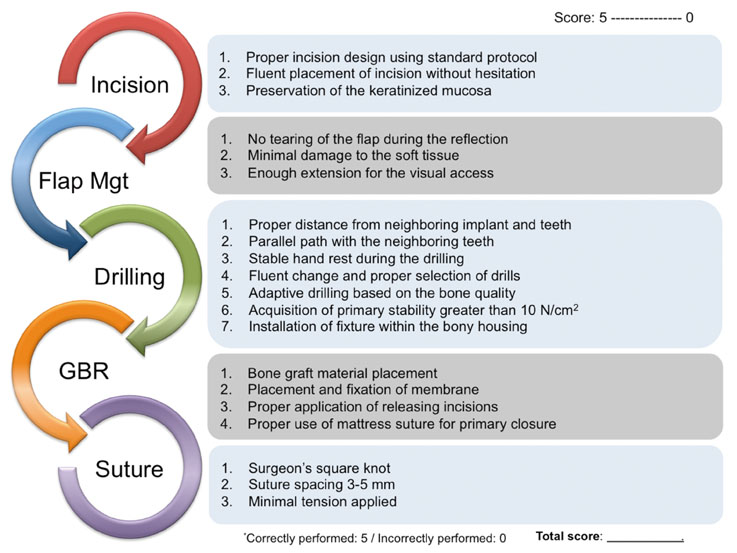J Periodontal Implant Sci.
2012 Feb;42(1):25-29. 10.5051/jpis.2012.42.1.25.
Development of the implant surgical technique and assessment rating system
- Affiliations
-
- 1Department of Periodontology, Research Institute for Periodontal Regeneration, Yonsei University College of Dentistry, Seoul, Korea. dentall@yuhs.ac
- KMID: 2212083
- DOI: http://doi.org/10.5051/jpis.2012.42.1.25
Abstract
- PURPOSE
There has been no attempt to establish an objective implant surgical evaluation protocol to assess residents' surgical competence and improve their surgical outcomes. The present study presents a newly developed assessment and rating system and simulation model that can assist the teaching staffs to evaluate the surgical events and surgical skills of residents objectively.
METHODS
Articles published in peer-reviewed English journals were selected using several scientific databases and subsequently reviewed regarding surgical competence and assessment tools. Particularly, medical journals reporting rating and evaluation protocols for various types of medical surgeries were thoroughly analyzed. Based on these studies, an implant surgical technique assessment and rating system (iSTAR) has been developed. Also, a specialized dental typodont was developed for the valid and reliable assessment of surgery.
RESULTS
The iSTAR consists of two parts including surgical information and task-specific checklists. Specialized simulation model was subsequently produced and can be used in combination with iSTAR.
CONCLUSIONS
The assessment and rating system provided may serve as a reference guide for teaching staffs to evaluate the residents' implant surgical techniques.
MeSH Terms
Figure
Reference
-
1. Carter BN. The fruition of Halsteds concept of surgical training. Surgery. 1952. 32:518–527.2. Moorthy K, Munz Y, Sarker SK, Darzi A. Objective assessment of technical skills in surgery. BMJ. 2003. 327:1032–1037.
Article3. Reznick RK. Teaching and testing technical skills. Am J Surg. 1993. 165:358–361.
Article4. Scott DJ, Valentine RJ, Bergen PC, Rege RV, Laycock R, Tesfay ST, et al. Evaluating surgical competency with the American Board of Surgery In-Training Examination, skill testing, and intraoperative assessment. Surgery. 2000. 128:613–622.
Article5. Kopta JA. An approach to the evaluation of operative skills. Surgery. 1971. 70:297–303.6. Reznick R, Regehr G, MacRae H, Martin J, McCulloch W. Testing technical skill via an innovative "bench station" examination. Am J Surg. 1997. 173:226–230.
Article7. Fraser SA, Klassen DR, Feldman LS, Ghitulescu GA, Stanbridge D, Fried GM. Evaluating laparoscopic skills: setting the pass/fail score for the MISTELS system. Surg Endosc. 2003. 17:964–967.8. Cremers SL, Ciolino JB, Ferrufino-Ponce ZK, Henderson BA. Objective Assessment of Skills in Intraocular Surgery (OASIS). Ophthalmology. 2005. 112:1236–1241.
Article9. Francis NK, Hanna GB, Cuschieri A. The performance of master surgeons on the Advanced Dundee Endoscopic Psychomotor Tester: contrast validity study. Arch Surg. 2002. 137:841–844.10. Taffinder N, Sutton C, Fishwick RJ, McManus IC, Darzi A. Validation of virtual reality to teach and assess psychomotor skills in laparoscopic surgery: results from randomised controlled studies using the MIST VR laparoscopic simulator. Stud Health Technol Inform. 1998. 50:124–130.11. Goff BA, Lentz GM, Lee D, Fenner D, Morris J, Mandel LS. Development of a bench station objective structured assessment of technical skills. Obstet Gynecol. 2001. 98:412–416.
Article12. Martin JA, Regehr G, Reznick R, MacRae H, Murnaghan J, Hutchison C, et al. Objective structured assessment of technical skill (OSATS) for surgical residents. Br J Surg. 1997. 84:273–278.
Article13. Lekholm U, Zarb GA. Patient selection and preparation. 1985. Chicago: Quintessence.14. Brånemark PI, Hansson BO, Adell R, Breine U, Lindström J, Hallén O, et al. Osseointegrated implants in the treatment of the edentulous jaw. Experience from a 10-year period. Scand J Plast Reconstr Surg Suppl. 1977. 16:1–132.15. Adell R, Lekholm U, Branemark PI. Surgical procedures. 1985. Chicago: Quintessence.16. Lekholm U, Jemt T. Principles for single tooth replacement. 1989. Chicago: Quintessence.17. Palacci P, Ericsson I, Engstrand P, Rangert B. Optimal implant positioning and soft tissue management for the branemark system. 1995. Chicago: Quintessence.18. Friberg B, Nilson H, Olsson M, Palmquist C. Mk II: the self-tapping Brånemark implant: 5-year results of a prospective 3-center study. Clin Oral Implants Res. 1997. 8:279–285.
Article19. Lindhe J, Karring T, Lang NP. Clinical periodontology and implant dentistry. 2003. 4th ed. Oxford: Blackwell.20. Schuwirth LW. Assessing medical competence: finding the right answers. Clin Teach. 2004. 1:14–18.
Article
- Full Text Links
- Actions
-
Cited
- CITED
-
- Close
- Share
- Similar articles
-
- Cross-platform digital assessment forms for evaluating surgical skills
- The effect of osteotome technique on primary implant stability according to implant fixture diameter
- An analysis on satisfaction level of clinicians on implant surgical guidance system based on computed tomography
- Clinical study on survival rate of osseointegrated implants
- Development of a Program Outcomes Assessment System based on Course Embedded Assessment for Nursing Education



